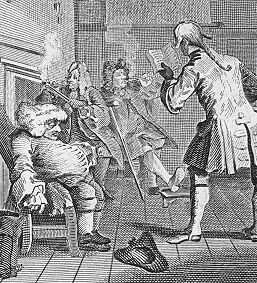The Eighteenth Century
 The 18th century was an important exploratory period in the development of the English society and letters. It was a century that faced the challenge of the Enlightenment, social turmoil from capitalism and revolution, and perhaps most significantly, the growth of cities and the rise of industrialization. This was also the age that saw Great Britain's power and confidence increase. Special Collections of Oberlin College Library holds numerous examples of 18th century works that constitute good exemplars of the intellectual output of the age. There are, for instance, books by John Locke, John Wesley, Adam Smith, Captain James Cook, Edward Gibbon, Thomas Paine, Viscount Bolingbroke, Edmund Burke, Mary Wollstonecraft, Joseph Priestly, Jonathon Edwards, Samuel Johnson, Benjamin Franklin, and more. Important adjuncts to these English language thinkers are the many French 18th century works by Voltaire, Jean Jacques Rousseau, and Denis Diderot (some in early English translations). Special Collections also holds a rich collection of scientific (particularly botanical) books and hundreds of maps, prints, and books from the collection of Robert Campbell that features his interest in London, industrialization and inland navigation of England and New England during this time of social upheaval.
The 18th century was an important exploratory period in the development of the English society and letters. It was a century that faced the challenge of the Enlightenment, social turmoil from capitalism and revolution, and perhaps most significantly, the growth of cities and the rise of industrialization. This was also the age that saw Great Britain's power and confidence increase. Special Collections of Oberlin College Library holds numerous examples of 18th century works that constitute good exemplars of the intellectual output of the age. There are, for instance, books by John Locke, John Wesley, Adam Smith, Captain James Cook, Edward Gibbon, Thomas Paine, Viscount Bolingbroke, Edmund Burke, Mary Wollstonecraft, Joseph Priestly, Jonathon Edwards, Samuel Johnson, Benjamin Franklin, and more. Important adjuncts to these English language thinkers are the many French 18th century works by Voltaire, Jean Jacques Rousseau, and Denis Diderot (some in early English translations). Special Collections also holds a rich collection of scientific (particularly botanical) books and hundreds of maps, prints, and books from the collection of Robert Campbell that features his interest in London, industrialization and inland navigation of England and New England during this time of social upheaval.
The 18th century also saw the creation in England of the first newspapers, weekly journals, and circulating libraries. In that regard, Special Collections of Oberlin College Library boasts complete runs of The Spectator, The Tatler, The Mirror, and Gentlemen's Magazine. In a more gossipy vein, readers will find the nine volumes of Literary Anecdotes of the Eighteenth Century by John Nichols, as well as the works by William Hogarth, James Boswell, and Charles Pigott.
This change in cultural and political ideas was coincidental with a tremendous shift in literary forms. Rising literacy itself was, in this revolutionary time, both the symptom and sometimes the cause of the spread of democratic ideologies and new religious movements among the middle classes. Notably, in a period of less than 50 years, it was the novel, in various forms, that came to rapidly dominate English prose narrative. By the end of the 18th century, the novel was second only to the religious sermon in its command of the print universe. Writing had become a sometimes lucrative, boom industry; commercial motivation gained a new foothold in writing, printing, engraving and book selling. The rise in the importance of women as authors and readers is another feature of the period. While the most frequently studied works of the period are by men, the majority of 18th century novelists were in fact women. In addition, while both genders read novels, it was most often a female readership that was assumed by authors.
Although there are numerous 18th century literary landmarks worth studying in both fiction and non-fiction, the five dominant writers of the age which have come to form the canonical nucleus of novel writing are Daniel Defoe, Henry Fielding, Tobias Smollett, Laurence Sterne, and Samuel Richardson. Collectively, the work represented by these authors came to displace all other genres of prose writing, and Special Collections holds numerous 18th century examples of their work. Special Collections also holds works by Alexander Pope, Jonathon Swift, Ann Radcliffe, Horace Walpole, Oliver Goldsmith, and Fanny Burney, to name a few more, that continue to be studied by students of English literature. You can also access Eighteenth Century Fiction online through the library's OhioLINK databases where you can read or search the full text of 96 works of prose fiction written in the British Isles from 1700-1780. We also have access to the English Short Title Catalogue, and the comprehensive digital edition Eighteen Century Collections Online based on the ESTC. ECCO has aimed to include every significant English-language and foreign-language title printed in the United Kingdom, along with thousands of important works from the Americas, between 1701 and 1800, currently over 180,000 titles.
Because Oberlin College Library's Special Collections has actual 18th century artifacts, students have the opportunity to examine the material history of literature. The texts in Special Collections can be paged for examination of their physicality, as products of both machine manufacturing and handcraft. Books, like many objects, embody a cultural aesthetic, moral judgements, and clue us in to the material and economic conditions used to produce them. If we are astute, we can spot the textual variations, the physical imperfections, and even reader annotations and custom bindings that make every copy from the hand press age potentially significant. When searching OBIS, try limiting your searches to the location "Main Special Collections" in order to delve into our rare book collection.